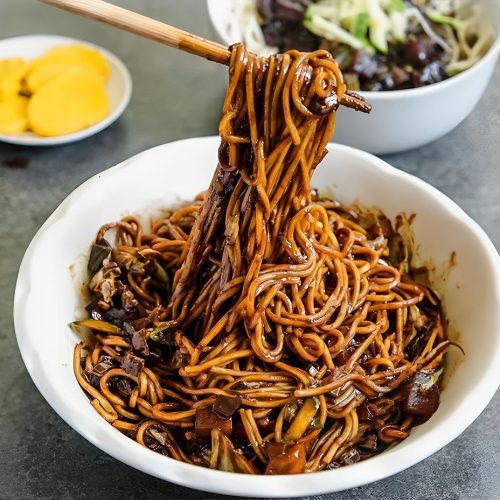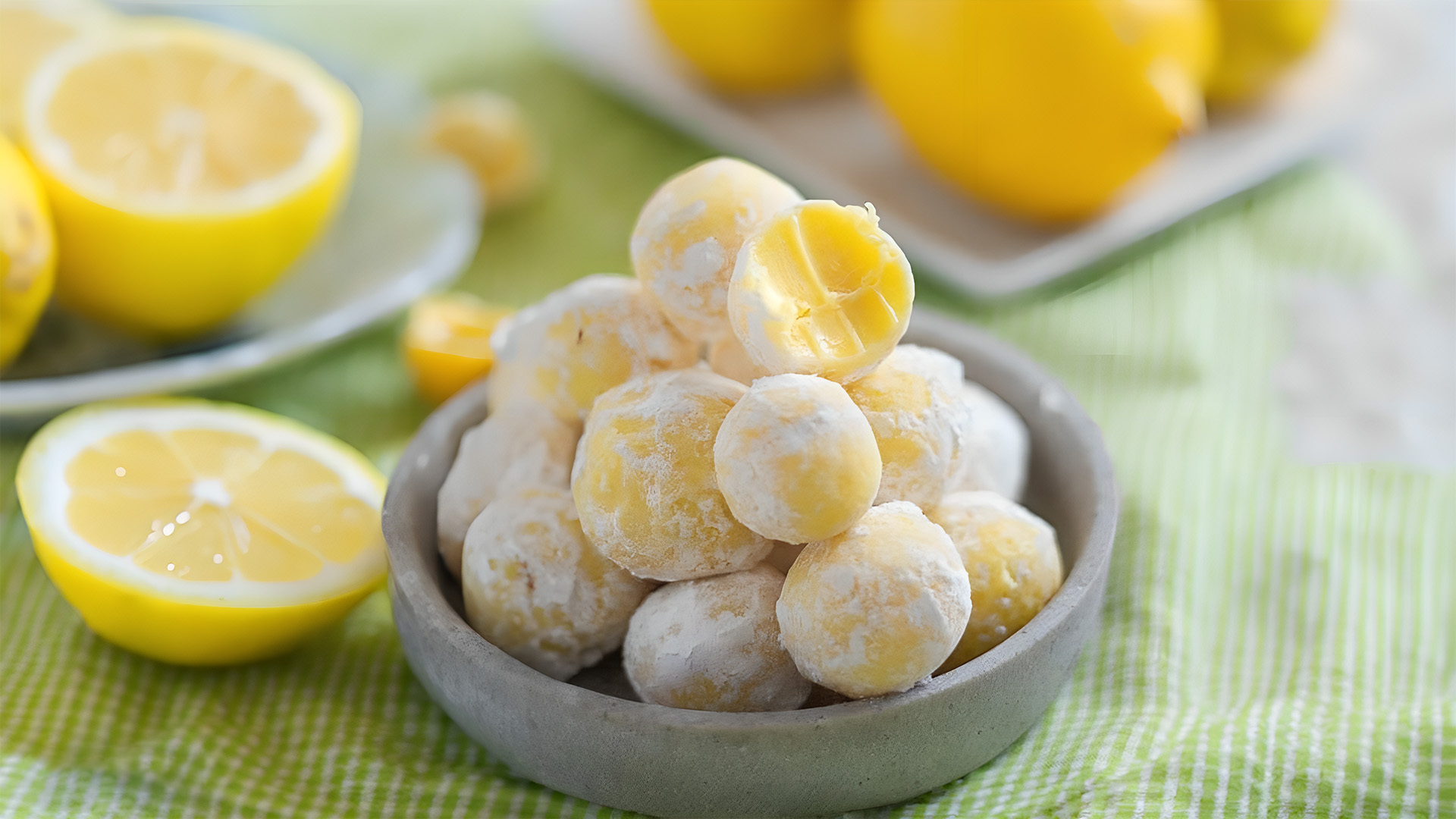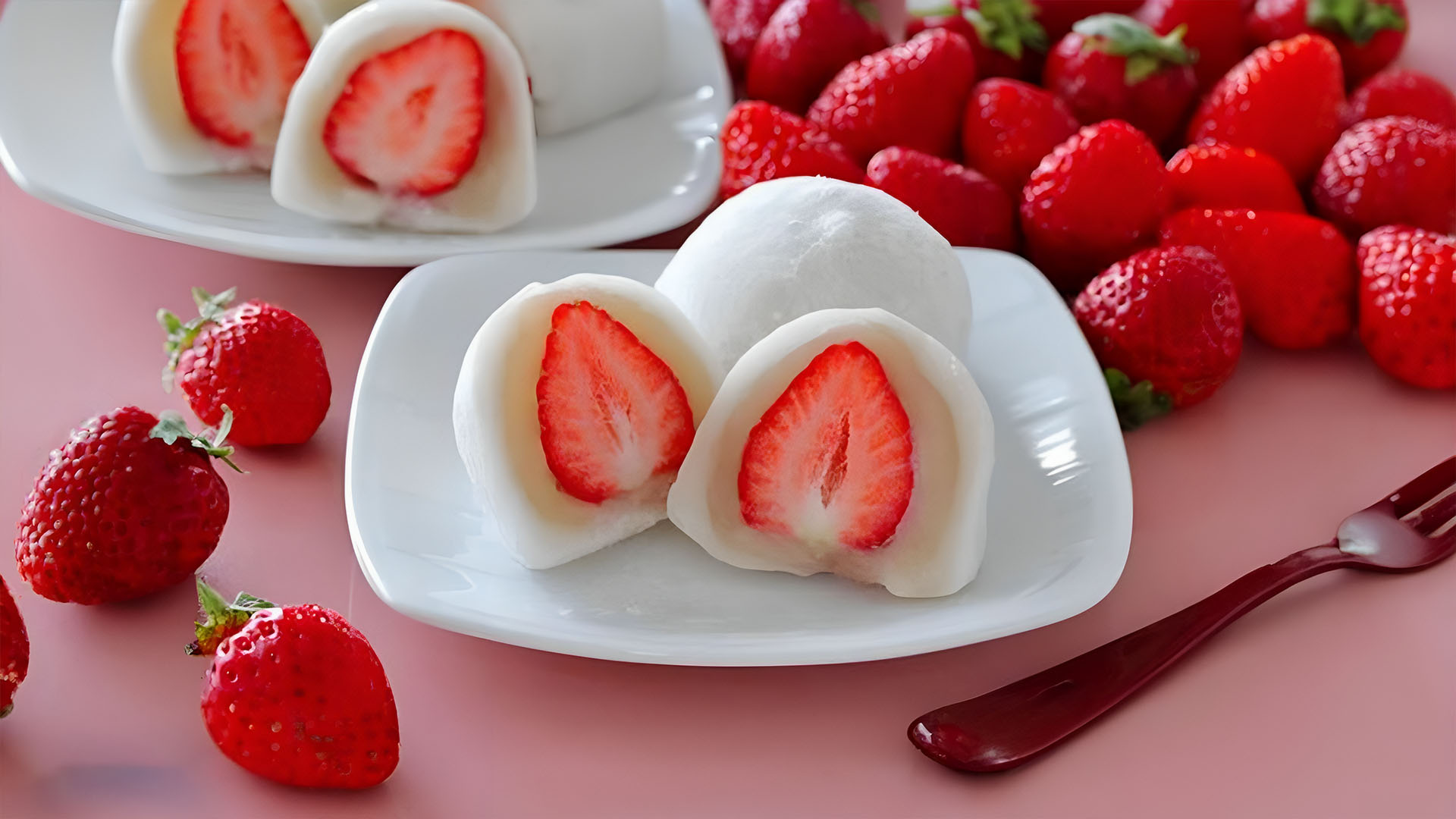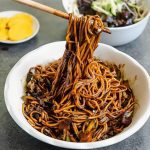Jjajangmyeon Recipe – Jjajangmyeon, often known as “jjajang,” is a popular Korean noodle dish that has captured the hearts and palates of people all over the world. This delectable meal is a classic of Korean cuisine, offering a symphony of flavors and textures. In this post, we’ll look at the reasons behind jjajangmyeon’s popularity, see what foods go well with it, provide techniques for boosting its flavor, and answer the age-old question of whether kimchi is a good companion. You’ve come to the correct site if you want to learn about the interesting world of jjajangmyeon, including its taste profile and a jjajangmyeon recipe to cook it at home.
Jjajangmyeon Recipe (Korean Noodles with Black Bean Sauce)
What is Jjangmyeon?
Jajangmyeon is a famous Korean-Chinese noodle dish topped with chunjang (a salty black soybean paste), chopped pork, and vegetables. In the late nineteenth century, Chinese migrant workers in Incheon, Korea, began producing zhajiangmian. Korean variations, such as a darker and sweeter sauce, distinguish the Korean meal from the Chinese one. Variations on the meal include shellfish or other meats.
Jajangmyeon is traditionally cooked with thick wheat noodles wrapped in black bean sauce. Chunjang is fried with additional ingredients such as meat, veggies, stock, and starch slurry to make the sauce. Typically, the sauce is thick and rich, with a slightly sweet and savory flavor.
Jajangmyeon is traditionally eaten with pickled vegetables like danmuji (yellow pickled radish) and kimchi. It can also be topped with a fried egg or chopped scallions.

What Pairs Well with Jjajangmyeon?
Jjajangmyeon, a popular Korean meal, is wonderfully matched by a selection of side dishes that complement the dining experience. Danmuji (pickled radish), sliced cucumbers, raw onions, and kimchi are popular accompaniments, each providing a distinct contrast to the dish’s savory and rich flavors. Furthermore, options like black vinegar, fresh or pickled radishes, fried mandu (dumplings), and even a side of jjamppong (spicy seafood noodle soup) These side dishes not only provide a variety of flavors and textures to the meal, but they also give a refreshing contrast to the rich and savory quality of Jjajangmyeon. Feel free to mix & combine to create a customized eating experience that meets your tastes.
How to Make Jjajangmyeon Taste Better?
Enhancing the flavor of jjajangmyeon can be a fun culinary adventure. Here are some tips on how to make jajangmyeon taste better:
- Fresh Ingredients: For the sauce, use fresh veggies and high-quality meat or fish. Fresh ingredients may make a big difference in flavor.
- Roasted Black Bean Paste: Before putting the black bean paste in the sauce, toast it. This might add depth and richness to it.
- Balance the Sauce: Make sure the sauce has a good mix of sweetness and saltiness. The sweetness can be adjusted with sugar or honey, and the saltiness with soy sauce or oyster sauce. Adjust the seasoning to taste.
- Quality Noodles: For the best texture, whether using fresh or dried noodles, use high-quality alternatives. The appropriate level of doneness for the noodles is critical to the overall experience.
- Garnishes: Use garnishes to add flavor and texture. Green onions, sesame oil, or toasted sesame seeds can be added to the dish to make it more appealing.
- Fresh vegetables: For extra taste and texture, use a variety of fresh veggies, such as diced zucchini, potato, or onion. These vegetables can provide a tasty counterpoint to the thick sauce.
- Sauce consistency: Make sure the sauce is the proper consistency. It should be glossy and thick, uniformly coating the noodles without being too dense. As needed, adjust the water content.
- Use High-Quality Meat or Seafood: If you’re going to include meat or seafood in your Jjajangmyeon, choose high-quality cuts. Quality components can have a big impact on the overall flavor.
By following these guidelines and paying attention to the quality and balance of ingredients, you can make a Jjajangmyeon that is full of flavor and provides a great dining experience. Experiment with these recommendations to personalize the dish to your tastes and enjoy a more enjoyable supper.
How does Jjajangmyeon Taste?
Jajangmyeon has a flavor that is slightly sweet, flavorful, and nutty. The black bean sauce is thick and savory, with a smokiness to it. The noodles are chewy and filling, with a hint of crunch and brightness from the pickled vegetables.
The overall flavor of jajangmyeon is frequently regarded as both cozy and pleasant. It’s a hearty dish that’s ideal for a cold day or when you’re in the mood for something delicious and comforting.
Why Do Koreans Eat Jjajangmyeon?
Jjajangmyeon is a popular and appreciated meal in South Korea for a variety of reasons. Here are some of the major aspects that contribute to its popularity:
- Delicious Flavor: Jjajangmyeon has a distinct and delectable flavor. The rich, savory sauce, created from black bean paste, has a delicious umami character and is somewhat sweet and gently salty. The combination of soft meat or seafood and a variety of veggies gives the meal depth.
- Simplicity: Jjajangmyeon is a convenient and quick lunch alternative that is often liked for its simplicity. It’s a go-to option for hectic days when people want a filling and savory lunch or dinner without having to spend time in the kitchen.
- Affordability: Jjajangmyeon is a reasonably priced dish that is accessible to a wide spectrum of individuals. It’s a popular alternative for individuals looking for low-cost dining options, whether dining out or ordering takeaway.
- Comfort Food: In South Korea, jjajangmyeon is considered a comfort food. It evokes feelings of nostalgia and familiarity, and is frequently connected with festivities, special occasions, and family gatherings.
- Adjusted food: Jjajangmyeon can be adjusted to suit individual preferences, while being traditionally made with meat or seafood. Some varieties contain vegetarian Jjajangmyeon or other nutritional elements.
More Noodles Recipes
Looking for more noodles recipe? or Korean recipes? You can try some of this:
Jjajangmyeon Recipe
After all the information above, now let’s get into the recipe and how to make this food

Jjajangmyeon Recipe
Equipment
- Frying Pan or Wok
- Pot
- Knife and Cutting Board
- Stirring Utensil
- Measuring Cups and Spoons
- Cooking Oil
- Potato Peeler
- Cooking Pot for Noodles:
- Strainer or Colander
- Noodle Serving Bowl
- Kitchen Utensils
Ingredients
- 200g pork or beef (finely chopped)
- 1/2 cup black bean paste
- 1 onion (finely chopped)
- 1 small zucchini (diced)
- 1 small potato (diced)
- 1/2 cup water
- 1 tbsp sugar
- 2 tbsp vegetable oil
- Salt and pepper to taste
- Fresh noodles (or dried noodles)
- Optional: sliced cucumbers, danmuji (pickled radish), or raw onions as side dishes
Instructions
- In a large skillet, heat the vegetable oil and brown the meat. Get rid of any excess fat.
- Continue to sauté the chopped onions until they become transparent.
- Cook for a few minutes after adding the black bean paste.
- Cook for a few minutes more after adding the diced zucchini and potato.
- Pour in the water, sugar, and continue to cook until the veggies are soft and the sauce has thickened.
- Cook the noodles according to package directions while the sauce simmers.
- Serve the sauce over the prepared noodles, along with any additional side dishes.
Conclusion for Jjajangmyeon Recipe
Finally, Jjajangmyeon is a popular Korean meal known for its distinct and delectable flavor. The rich, savory, and slightly sweet sauce produced from black bean paste (chunjang) is the dish’s main draw. The umami depth of the sauce, along with soft bits of meat, veggies, and occasionally fish, results in a harmonious and gratifying flavor experience.
Jjajangmyeon has a delightful balance of sweetness and saltiness, which is enhanced by the mild, neutral foundation of the noodles. Because of the combination of flavors and textures, Jjajangmyeon has become a comfort food and a favorite among people looking for a hearty and delicious lunch. Also follow our facebook fanspage Nero Yummy and Pinterest.











Leave a Reply